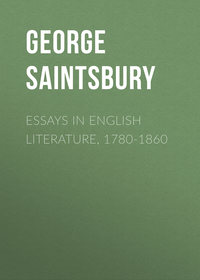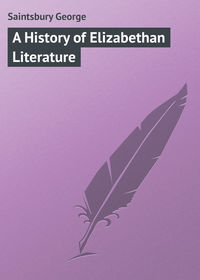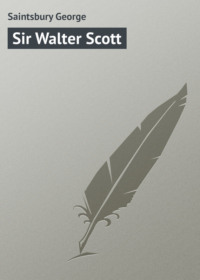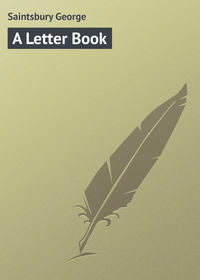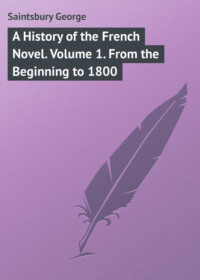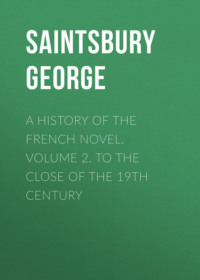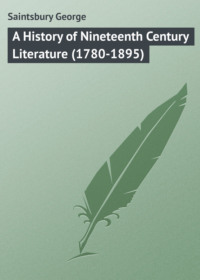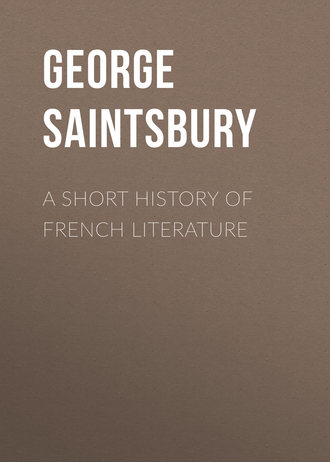 полная версия
полная версияA Short History of French Literature
The unique individuality and the extraordinary merit of the various pieces which make up Molière's theatre have made it necessary to give a tolerably minute account of them, and that account will to a certain extent dispense us from dealing with his general characteristics at great length, especially as a few remarks on French comedy of the Molièresque kind as a whole will have to be given at the end of this chapter. Independently of the characters which Molière shares with all the great names of literature, his fertility and justness of thought, the felicity of the expression in which he clothes it, and his accurate observation of human life, there are two points in his drama which belong, in the highest degree, to him alone. One is the extraordinary manner in which he manages to imbue farce and burlesque with the true spirit of refined comedy. This manner has been spoken of by unfriendly critics as 'exaggerated,' but the reproach argues a deficiency of perception. Even the most roaring farces of Molière, even such pieces as M. de Pourceaugnac and the Bourgeois Gentilhomme, demand rank as legitimate comedy, owing to his unmatched faculty of intimating a general purpose under the cloak of the merely ludicrous incidents which are made to surround the fortunes of a particular person. This general purpose (and here we come to the second point) is invariably a moral one. Of all dramatists, ancient and modern, Molière is perhaps that one who has borne most constantly in mind the theory that the stage is a lay-pulpit and that its end is not merely amusement, but the reformation of manners by means of amusing spectacles. Occasionally, no doubt, he has pushed this purpose too far and has missed his mark. He has never given us, and perhaps could not have given us, such examples of dramatic poetry of the non-tragic sort as Shakespeare and Calderon have given. Indeed, it seems to be a mistake to call Molière a poet at all, despite his extraordinary creative faculty. He was too positive, too much given to literal transcription of society, too little able to convey the vague suggestion of beauty which, as cannot be too often repeated, is of the essence of poetry. But, if we are content to regard drama as a middle term between poetry and prose, he, with the two poets just named, must be appointed to the first place in it among modern authors. In brilliancy of wit he is, among dramatists, inferior only to Aristophanes and Congreve. But he took a less Rabelaisian licence of range than Aristophanes, and he never, like Congreve, allows his action to drift aimlessly while his characters shoot pleasantries at one another. If we leave purely poetic merit out of the question and restrict the definition of comedy to the dramatic presentment of the characters and incidents of actual life, in such a manner as at once to hold the mirror up to nature and to convey lessons of morality and conduct, we must allow Molière the rank of the greatest comic writer of all the world. Castigat ridendo mores is a motto which no one challenges with such a certainty of victory as he.
Although the number and the diversity of Molière's works were well calculated to encourage imitators, it was some time before the imitators appeared. Unlike Racine, whose method was at once caught up, Molière saw during his lifetime no one who could even pretend to be a rival. Those who are now classed as being in some degree of his time were for the most part in their cradles when his masterpieces were being acted. Regnard, the best of them, was born two years after the appearance of Le Dépit Amoureux and only three years before the appearance of Les Précieuses Ridicules. Baron was his pupil and adoring disciple. Dufresny was but just of age, and Dancourt but ten years old, at his death. Brueys and Palaprat (the Beaumont and Fletcher, mutatis mutandis, of the French stage) did not make up their curious association till long after that event, at the date of which Le Sage was five years old. Quinault, Boursault, and Montfleury alone were in active rivalry with him, and though none of them was destitute of merit, the merit of none of them was in the least comparable to his. He owed this advantage, for such it was, to his relatively early death and to the wonderfully short space of time in which his masterpieces were produced. Molière is identified with the age of Louis XIV., yet Les Précieuses Ridicules was written years after the king's nominal accession, and even after his actual assumption of the reins of government from the hands of Mazarin, while Le Malade Imaginaire was acted by its dying author more than forty years before the great king's reign ended.
Contemporaries of Molière.
The three authors just mentioned as actually contemporary with Molière require no very lengthy notice. Quinault may almost be said to have founded a new literary school (in which none of his pupils has surpassed him) by the excellence of his operas. Of these Armida is held the best. His comedies proper are not quite so good as his operas, but much better than his tragedies. One of them, L'Amant Indiscret, supplied Newcastle and Dryden with hints to eke out L'Étourdi, and most of them show a considerable command of comic situation, if not of comic expression. Montfleury, whose real name was Antoine Jacob, was, like Molière, an actor. He belonged to the old or rival company of the Hôtel de Bourgogne, and was born in 1640. He wrote sixteen comedies, partly on contemporary subjects and partly adaptations of Spanish originals. The two best are La Femme Juge et Partie and La Fille Capitaine. They belong to an older style of comedy than Molière's, being both extravagant and coarse, but there is considerable vis comica in them. Boursault, who was born in 1638 and died in 1701, had still more merit, though he too was an enemy of Molière. His Mercure Galant is his principal play, besides which Ésope à la Cour, Ésope à la Ville, and Phaeton may be mentioned. He was decidedly popular both as a man and a writer. Vanbrugh imitated more than one of his plays. In all these comedies a certain smack of the pre-Molièresque fancy for Comédies des Chansons and other tours de force may be perceived. Besides these three writers others of Molière's own contemporaries wrote comedies with more or less success. La Fontaine himself was a dramatist, though his dramas do not approach his other work in excellence. Thomas Corneille wrote comedies, but none of importance; and Campistron attained a certain amount of success in comic as in tragic drama. No one of these, however, approached the authors of the younger generation who have been mentioned.
The School of Molière-Regnard.
Jean François Regnard, the second of French comic dramatists in general estimation (though it is doubtful whether any single piece of his equals Turcaret), was born at Paris in 1656, and lived a curious life. He was heir to considerable wealth and increased it, singular to say, by gambling. He had also a mania for travelling, and when he was only two-and-twenty was captured by an Algerian corsair and enslaved. After some adventures of a rather dubious character he was ransomed, but continued to travel for some years. At last he returned to France, bought several lucrative offices and an estate in the country, and lived partly there and partly at Paris, writing comedies and indulging largely in the pleasures of the table. He died at his château of Grillon in 1710, apparently of a fit of indigestion; but various legends are current about the exact cause of his death. He wrote twenty-three plays (including one tragedy of no value) and collaborated with Dufresny in four others. Many of these pieces were comic operas. At least a dozen were represented by the 'Maison de Molière.' The best of them are Le Joueur, Le Distrait, Les Ménéchmes, Le Légataire, the first and the last named being his principal titles to fame. Regnard trod as closely as he could in the steps of Molière. He was destitute of that great dramatist's grasp of character and moral earnestness; but he is a thoroughly lively writer, and well merited the retort of Boileau (by no means a lenient critic, especially to the young men who succeeded his old friend), when some one charged Regnard with mediocrity, 'Il n'est pas médiocrement gai.'
Baron the actor was born in 1643 and died in 1729, after having long been the leading star of the French stage. He wrote, though it is sometimes said that he was aided by others, seven comedies. One of these, L'Andrienne, is a clever adaptation of Terence, and another, L'Homme aux Bonnes Fortunes, has considerable merit in point of writing and of that stage adaptability which few writers who have not been themselves actors have known how to master.
Charles Rivière Dufresny, a descendant of 'La Belle Jardinière,' one of Henri IV.'s village loves, was born in 1648 and died in 1724. He was a great favourite of Louis XIV. and a kind of universal genius, devoting himself by turns to almost every branch of literature and of the arts. He was, however, incurably desultory, and was besides a man of disorderly life. His comedies were numerous and full of wit and knowledge of the world, but somewhat destitute of finish. Besides those in which Regnard collaborated he was the author of eleven pieces, of which L'Esprit de Contradiction, Le Double Veuvage, La Coquette de Village, and La Réconciliation Normande are perhaps the best.
Florent Carton Dancourt was born in 1661 and died in 1725. He too was a favourite of Louis XIV., but, unlike Dufresny, he was an actor as well as an author. Towards the end of his days, having made a moderate fortune, he betook himself to a country life and to the practice of religious duties. His théâtre is considerable, extending to twelve volumes. The great peculiarity of his comedies is that they deal almost exclusively with the middle class. Les Bourgeoises de Qualité and Le Chevalier à la Mode, perhaps also Le Galant Jardinier and Les Trois Cousines, deserve mention.
The collaboration of Brueys and Palaprat resulted in the modern version of the famous mediaeval farce, L'Avocat Pathelin, and in an excellent piece of the Molière-Regnard type, Le Grondeur. Some other plays of less merit were written by the friends, while each is responsible for two independent pieces. Both were Provençals, David Augustin de Brueys having been born at Aix in 1640, Jean Palaprat at Toulouse ten years later. Brueys, who, as an abbé converted by Bossuet and engaged actively in propagating his new faith, had some difficulty in appearing publicly as a dramatic author, is understood to have had the chief share in the composition of the joint dramas.
Characteristics of Molièresque Comedy.
The general characteristics of this remarkable comedy are not hard to define. Based as it was, after Molière had once set the example, on the direct study of the actual facts of society and human nature, it could not fail to appeal to universal sympathy in a very different degree from the artificial tragedy which accompanied it. It was, moreover, far less trammelled by rules than the sister variety of drama. Unities did not press very heavily on the comic dramatist; his choice and number of characters, his licence of action on the stage, and so forth, were unlimited; he could write in prose or verse at his pleasure, and, if he chose verse, he was bound to a much less monotonous kind of it than his tragic brother. Consequently the majority of the objections which lie against the masterpieces of Corneille and Racine, and which make the work of their imitators almost unreadable, leave Molière and his followers unscathed. One drawback only remained, the drawback already commented on in the case of tragedy, and admitted by French critics themselves in some such terms as that Shakespeare took individuals, Molière took types. The advantage of the latter method for enforcing a moral lesson is evident; its literary disadvantages are evident likewise. It leads to an ignoring of the complexity of human nature and to an unnatural prominence of the 'ruling passion.' The highest dramatic triumphs of single character in comedy, Falstaff, Rosalind, Beatrice, become impossible. As it has been remarked, the very titles of these plays, Le Misanthrope, Le Joueur, Le Grondeur, show their defects. No man is a mere misanthrope, a mere gambler, a mere grumbler; and the dramatist who approaches comedy from the side of Molière is but too apt to forget the fact in his anxiety to enforce his moral and deepen the strokes of his general type.
CHAPTER III
NOVELISTS
D'Urfé.
Prose fiction, for reasons which it is not at all hard to discover, is in its more complete forms always a late product of literature. Up to the beginning of the seventeenth century, France had known nothing of it except the short prose tales which had succeeded the Fabliaux, and which had been chiefly founded on imitation of the Italians, with the late and inferior prose versions of the romances of chivalry, the isolated masterpiece of Gargantua and Pantagruel, and the translated and adapted versions of the Amadis and its continuations. The imitation of Spanish literature was constant in the early seventeenth century, and the great wave of conceited style which, under the various names of Euphuism, Gongorism, Marinism, invaded all the literary countries of Europe, did not spare France. The result was a very singular class of literature which, except for a few burlesque works, almost monopolised the attention of novelists during the first half of the century. The example of it was in a manner set by Honoré d'Urfé in the Astrée, which was, however, rather pastoral than heroic. D'Urfé, who was a man of position and wealth in the district of Forez, imagined, on the banks of the Lignon, a stream running past his home, a kind of Arcadia, the popularity of which is sufficiently shown by the adoption of the name of the hero, Céladon, as one of the stock names in French for a lover. He took, perhaps, some of his machinery from the Aminta of Tasso and from the other Italian pastorals, but he emulated the Amadis in the interminable series of adventures and the long-windedness of his treatment. He had, however, some literary power, while the necessary verisimilitude was provided for by the adaptation of numerous personal experiences, and the book has preserved a certain reputation for graceful sentiment and attractive pictures of nature. It was extraordinarily popular at the time and long afterwards, so much so that a contemporary ecclesiastic, Camus de Pontcarré, considered it necessary to supply an antidote to the bane in the shape of a series of Christian pastorals, the name of one of which, Palombe, is known, because of an edition of it in the present century.
The Heroic Romances.
D'Urfé belonged as much to the sixteenth as to the seventeenth century, though the Astrée was the work of the latter part of his life, and was indeed left unfinished by him. It was shortly afterwards, under the influence chiefly of the growing fancy for literary coteries, that the heroic romance properly so called was born. This was usually a narration of vast length, in which sometimes the heroes and heroines of classical antiquity, sometimes personages due more or less to the author's imagination, were conducted through a more than Amadis-like series of trials and adventures, with interludes and a general setting of high-flown gallantry. This latter possessed a complete jargon of its own, and (though the hypothesis of its power over the classical French drama is for the most part exaggerated) continued to exercise a vast influence on literature and on society, even after Molière had poured on its chief practitioners and advocates the undying mockery of his Précieuses Ridicules. There were three prominent authors in this style, Mademoiselle de Scudéry, La Calprenède, and Gomberville. Mademoiselle de Scudéry, known in the coterie nomenclature of the time as 'Sapho,' was the sister of Georges de Scudéry, and a woman of considerable talent and more considerable industry. Madeleine de Scudéry was born at Havre in 1607, and died at Paris in 1701, her life thus covering nearly the whole of the century of which she was one of the most conspicuous literary figures. She had no beauty – indeed she was very ugly – but the eccentric military and literary reputation of her brother and her own talents made her the centre and head of an important coterie in the capital. Her romances, the earliest of which was Ibrahim, were published under her brother's name, but their authorship was well known. She was extremely accomplished, not merely in the accomplishments of a blue-stocking but in art, and even in housewifery. After her series of romances was finished she published many volumes, chiefly condensed or extracted from them, containing Conversations of the moral kind, which attracted attention from some persons who had not condescended to the romances themselves. It ought never to be forgotten that among the most fervent admirers of her books and of their fellows was Madame de Sévigné, who was certainly almost as acute in literary criticism as she was skilful in literary composition. Her novels, the most famous of their class, are the Grand Cyrus, otherwise Artamène, Clélie, Ibrahim, or the Illustrious Bassa, and Almahide, the latter being partly, but chiefly in the name of the heroine, the source of Dryden's Conquest of Granada. The Grand Cyrus is, at least by title, the best remembered, but it is in Clélie that the best-known and most characteristic trait appears, the delineation and description namely of the Carte de Tendre242. Tendre is the country of love, through which flows the river of Inclination watering the villages of 'Pretty Verses,' 'Gallant Epistles,' 'Assiduity,' etc., while elsewhere in the region are the less cheerful localities of 'Levity,' 'Indifference,' 'Perfidy,' and so forth. La Calprenède, a Gascon by birth, was the author of Cléopâtre (which ranks perhaps with Cyrus as the chief example of the style), of Cassandre and of Pharamond. Gauthier de Coste (which was his personal name) figures, like most of the notable persons of the middle of the century, in the Historiettes of Tallemant, who says of him, 'Il n'y a jamais eu un homme plus Gascon que celui-ci.' The assertion is supported by some characteristic but not easily quotable anecdotes. The criticism of Tallemant, however, does not apply badly to the whole class of compositions. 'Les héros,' says he, speaking of Cassandre, 'se ressemblent comme deux gouttes d'eau, parlent tous Phébus (the euphuist jargon of the time), et sont tous des gens à cent mille lieues au dessus des autres hommes.' Marin le Roy, Seigneur de Gomberville, who was something of a Jansenist, attended rather to edification than gallantry in his Alcidiane, Caritée, Polexandre, and Cythérée. Though earlier in date he is inferior in power to Mademoiselle de Scudéry and to La Calprenède, the first of whom had some wit and much culture, while La Calprenède possessed a decided grasp of heroic character and some notion of the method of composing historical novels. Gomberville, a man of wealth and position, was also a writer of moral works. Putting the artificiality of the general style out of the question, the chief fault to be found with these books is their enormous length. They fill eight, ten, or even twelve volumes; they consist of five, six, or even seven thousand pages, though the pages are not very large and the print by no means close. Even the liveliest work – work like Fielding's or Le Sage's – would become tiresome on such a scale as this; and it is still incomprehensible how any one not having some special object to serve by it could struggle through such enormous wastes of verbiage and unreality as form the bulk of these novels. Even when the passion for the heroic style strictly so called began to wane no great improvement at first manifested itself. Catherine Desjardins243 (who wrote under the name of Madame de Villedieu) produced numerous books (the chief of which is Le Grand Alcandre), not indeed so absolutely preposterous in general conception, but even more vapid and destitute of originality and distinction244.
These impracticable and barren styles of fiction were succeeded in the latter half of the century by something much better. The Picaroon romance of Spain inspired Paul Scarron with the first of a long line of novels which, in the hands of Le Sage, Defoe, Fielding, and Smollett, enriched the literature of Europe with remarkable work. Madame de la Fayette laid the foundation of the novel proper, or story of analysis of character; and towards the close of the century the fairy tale attained, in the hands of Anthony Hamilton, Perrault and Madame d'Aulnoy, its most delightful and abundant development.
Scarron.
Paul Scarron was one of the most remarkable literary figures of the century in respect of originality and eccentric talent, though few single works of his possess formal completeness. He was of a family of Piedmontese origin and very well connected, his father, of the same name, being a member of the Parliament of Paris, and of sufficiently independent humour to oppose Richelieu. Paul Scarron the younger (he had had an elder brother of the same name who had died an infant) was born in 1610, and his mother did not outlive his third year. His father married again; the stepmother did not get on well with Paul, and he was half obliged and half induced to become an abbé. For some years he lived a merry life, partly at Rome, partly at Paris. But when he was still young a great calamity fell on him. A cock-and-bull story of his having disguised himself as a savage in a kind of voluntary tar-and-feather suit, and having been struck with paralysis in consequence of plunging into an ice-cold stream to escape the populace, is usually told, but there seems to be no truth in it. An attack of fever, followed by rheumatism and mismanaged by the physicians of the day, appears to have been the real cause of his misfortune. At any rate, for the last twenty years of his life he was hopelessly deformed, almost helpless, and subject to acute attacks of pain. But his spirit was unconquerable. He had some preferment at Le Mans and a pension from the queen, which he lost on suspicion of writing Mazarinades. Besides these he had what he called his 'Marquisat de Quinet,' that is to say, the money which Quinet the bookseller paid him for his wares. In 1652 he astonished Paris by marrying Françoise d'Aubigné, the future Madame de Maintenon, the granddaughter of Agrippa d'Aubigné. The strange couple seem to have been happy enough, and such unfavourable reports as exist against Madame Scarron may be set down to political malice. But Scarron's health was utterly broken, and he died in 1660 at the age of fifty. His work was not inconsiderable, including some plays and much burlesque poetry, the chief piece of which was his 'Virgil travestied,' an ignoble task at best, but very cleverly performed. His prose, however, is of much greater value. Many of his nouvelles, mostly imitated from the Spanish, have merit, and his Roman Comique245, though also inspired to some extent from the peninsula, has still more. It is the unfinished history of a troop of strolling actors, displaying extraordinary truth of observation and power of realistic description in the style which, as has been said, Le Sage and Fielding afterwards made popular throughout Europe.
Cyrano de Bergerac.
With Scarron may be classed another writer of not dissimilar character, but of far less talent, whose eccentricities have given him a disproportionate reputation even in France, while they have often entirely misled foreign critics. Cyrano de Bergerac was a Gascon of not inconsiderable literary power, whose odd personal appearance, audacity as a duellist, and adherence, after conversion, to the unpopular cause of Mazarin, gave him a position which his works fail to sustain. They are not, however, devoid of merit. His Pédant Joué, a comedy, gave Molière some useful hints; his Agrippine, a tragedy, has passages of declamatory energy. But his best work comes under the head of fiction. The Voyages à la Lune et au Soleil246, in which the author partly followed Rabelais, and partly indulged his own fancy for rodomontade, personal satire, and fantastic extravagance, have had attributed to them the great and wholly unmerited honour of setting a pattern to Swift. Cyrano, let it be repeated, was a man of talent, but his powers (he died before he was thirty-five) had not time to mature, and the reckless boastfulness of his character would probably have disqualified him at all times from adequate study and self-criticism. Personally, he is an amusing and interesting figure in literary history, but he is not much more. In company with him and with Scarron may be mentioned Dassoucy, alternately a friend and enemy of Cyrano, and a light writer of some merit.


